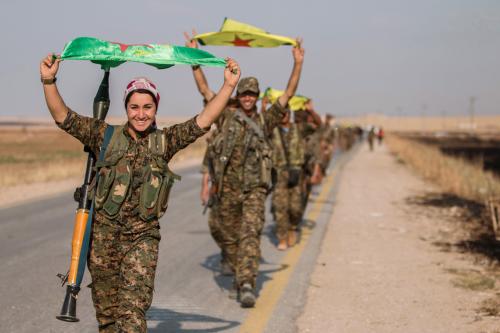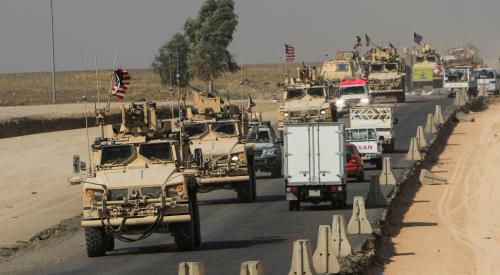Senior officials from governments fighting ISIS are meeting this week, and they would do well to consider how better to repatriate children of ISIS fighters. Disagreements over whether or not countries should be doing more to try to repatriate their citizens, particularly the children, remain. Yet rather than focusing on those seemingly intractable differences, members of the global coalition to defeat ISIS could usefully draw attention to the need to ensure that countries that do repatriate have the expertise and other capacities to do so effectively. Many currently do not.
The numbers
The numbers speak for themselves. According to the most recent U.N. figures, 66,101 people are being held in the deteriorating conditions in the al-Hol camp in northeast Syria, 96% of whom are women and children, with 66% of the children under 18 years old. Only some 350 children were repatriated between January and October of 2019, with almost three-quarters of them returning to Kazakhstan or Kosovo.
Meanwhile, too few governments have demonstrated a willingness to repatriate. Politicians often point to possible short-term security risks associated with the individuals or “dangers of sending emissaries to the region” to confirm citizenship, while minimizing the long-term risks of allowing their citizens, particularly children, to languish in detention camps. Yet, as the Washington Post editorial board recently wrote: “The longer the children stay, and the older they get, the more likely they themselves may be to grow up into a new Islamic State generation.”
Recent examples show the tightrope politicians need to navigate. For example, Norway’s governing coalition recently collapsed due to the government’s decision to repatriate a Norwegian woman and her two children from Syria so that one could receive medical treatment; in Tunisia, the president has been strongly criticized for repatriating ISIS children. Some governments have stripped suspected ISIS fighters and their family members of their citizenship, and others have debated doing so. This, despite calls from the U.N., the European Parliament, and a range of others for countries to repatriate children being held in the camps.
To repatriate or not is not the only question
Most of the public debate around repatriation has focused on whether or not to do so and the legal, logistical, and security obstacles involved. Less attention has been given to perhaps a more fundamental set of issues:
1) What are the needs and risks of the children and other individuals (who are not prosecuted for crimes that may have been committed while in the conflict zone or who are otherwise deemed not to pose a security risk to the community)?;
2) What type of framework could be used to facilitate their healthy and safe reintegration?;
3) Are countries, including those that have yet to facilitate repatriation, equipped with the capacities to address the needs and build and implement such a framework?; and
4) Are there training or other programs available — or that could be developed — to help build those capacities? More global attention on this set of issues, with a particular focus on children, is needed.
The needs are significant, but not new
Children who spent time in ISIS-controlled territories likely endured multi-layered, severe, and pervasive trauma. During visits to and program observations within Kazakhstan (by Steve Weine) and Kosovo (by Heidi Ellis), it was evident that some children were adjusting well despite the trauma, while others struggled.
The needs of these children were diverse. Some appeared to be experiencing symptoms consistent with post-traumatic stress disorder, such as nightmares, emotional dysregulation, numbing and anxiety. Others showed developmental delays, lagging far behind their peers in academic, linguistic, or fine motor development. Some were mute, hoarded food, or showed concern at cultural practices that were in conflict with what they had been taught. While the range of challenges is diverse, none are novel: Practitioners who work with children who have experienced trauma, adversity, and acculturative stress have accrued decades of experience in successfully helping children with similar challenges.
At the level of social integration, children and their mothers also face difficulties that, while challenging, are not entirely new. Some are encountering fear, stigma, and animosity within their schools and communities. While the specific nature of the stigma and fear may be unique in this context, here too existing knowledge bases can be brought to bear. Educators and researchers who have worked in areas such as reintegrating former child soldiers, stopping school bullying, or promoting refugee children’s integration in the school setting have wells of knowledge for addressing these challenges.
Perhaps what makes reintegrating children from ISIS seem so challenging is not that there is any one particular need that seems too great to be addressed, but that the interrelated needs create a multidimensional challenge that defies the standard siloed approach to training and intervention.
Responding to a multilayered challenge with a multilayered framework
In order to develop an integrated framework to address these overlapping, multilayered needs, we turned to the evidence. Existing evidence from the fields of refugee children, war-impacted children, former gang members, child victims of domestic abuse, and trafficking victims highlighted the different factors and processes that are likely to be needed to rehabilitate and reintegrate child returnees.
First, mental and other health services are needed to enable the child to recover from developmental, psychological, and physical injuries. Second, school success should be promoted through school involvement, particularly for distressed or developmentally-delayed youth, and returning children should have access to specialized educational programs, integrated psychosocial care, and bullying prevention programs. Third, promoting community and family support is critical. This includes strengthening community resilience and support to mitigate the stigma and discrimination that returning youth (or family members) may face, and mitigating family conflict through family education, support, and counseling. Finally, improving structural conditions and protecting public safety are essential. This means improving the living and working conditions for returnees and assessing their security risks as part of wider effort to prevent any future involvement in extremist or other violence.
Existing capacities
Operationalizing such an approach requires programs that involve trauma-informed care, social services, child protection workers, housing officers, and vocational training and support. It will involve plans for managing community reception and possible stigma; addressing educational issues, such as ones caused by gaps in formal education; and developmental issues, including those related to lagging social or developmental skills or developmental delays. Professionals with a variety of expertise are needed, often working in collaboration. The technical and other capacity challenges can be daunting, particularly given the range of professionals that will need to be involved, many of whom may require specialized training and skills and lack experience handling such politically sensitive cases.
Countries willing or being encouraged to repatriate their children (and perhaps other nationals) and interested in developing a comprehensive, evidence-based reintegration framework will likely need to consider a range of questions, including: 1) How will they build the capacity to support and sustain the needed services?; 2) How might they develop a multidisciplinary team or other approach that draws on experts from the relevant fields?; 3) How will such an initiative be financed?; and 4) What existing programs or other initiatives could be leveraged?
Many countries are looking at Kazakhstan as a potential model. It has embarked on perhaps the most ambitious effort to date, with its 17 regional rehabilitation and reintegration centers staffed with psychologists, social workers, psychiatrists, theologians, lawyers, nurses, and teachers, to help with the repatriation of more than 400 children. As in many other countries, particularly those without strong public health institutions, intensive training and ongoing case supervision of the mental and psychosocial care practitioners will be key ingredient for any such program. This raises the question of the availability of such assistance.
Mind the gap
The unfortunate reality is that despite the attention that the repatriation of ISIS family members has received in recent years — and the wealth of guidance that has been developed by the United Nations and other multilateral bodies — the capacity-building toolbox to support countries that might wish to repatriate remains extremely limited.
Currently, the approach remains largely ad hoc, centering on two-day regional conferences on the topic or having an individual expert (typically a mental health professional) visit a country for a limited time (e.g., one week) to meet with the relevant government and non-governmental experts. Beyond this, there is little training available on discrete issues such as trauma-informed mental health care, violence extremism risk assessment and prevention, child developmental assessment and support, or building family support or resilience. Training that begins to address the interrelated nature of these issues is even more scarce.
For their part, international donors should devote more attention to supporting the design and delivery of training in this so far largely neglected sphere. This could include having the Global Community Engagement and Resilience Fund, the world’s only multilateral funding mechanism to support locally-led initiatives to prevent violent extremism, mobilize resources and expertise from governments and the private sector to support such efforts. In addition, the World Bank and World Health Organization, both of which work to strengthen the public health institutions in countries around the world, could include a focus on ensuring these institutions are equipped to support the needs of the returning children, as well as their families and communities.
Perhaps more ambitiously, what is needed is a multidisciplinary group that includes the range of expertise needed for this population, and that can work with interested countries to develop and implement a comprehensive program. Such a group — which could receive support from governments, the U.N., and private donors — could bring together the diverse knowledge bases held by psychologists; psychiatrists; pediatricians; educators; researchers; social, youth, and health workers; and theologians. The group could address a key gap by providing integrated and sustained support, from the diversity of experts involved, to the countries facing the myriad challenges associated with the rehabilitation and reintegration of children and other family members returning from the conflict zone in Iraq and Syria. Although not an elixir, such a resource, which the senior government officials fighting ISIS could help bring to life at their meeting this week, may even increase the willingness of at least a few countries to repatriate their citizens.
The Brookings Institution is committed to quality, independence, and impact.
We are supported by a diverse array of funders. In line with our values and policies, each Brookings publication represents the sole views of its author(s).









Commentary
Minding the gap: How to provide more comprehensive support to the children of ISIS
January 28, 2020